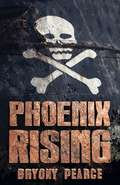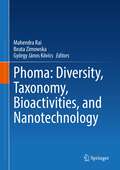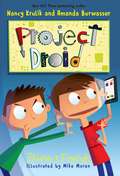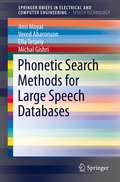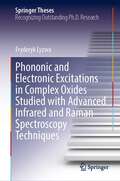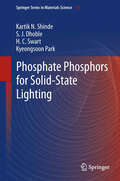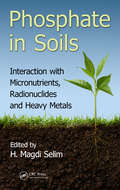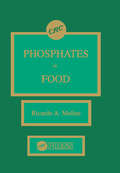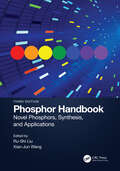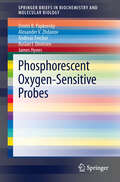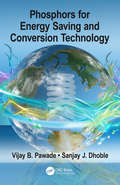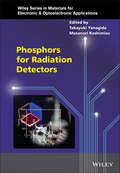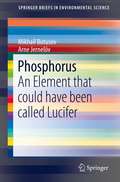- Table View
- List View
Phoenix Rising
by Karen HesseNyle Sumner is an orphan. And in spite of the fact that she and her grandmother live a good life on a Vermont sheep farm, she cannot forget that her father abandoned her. She cannot forget that her mother died in the back room of the farmhouse when Nyle was six. And she cannot forget that her grandfather died in that same room, just a few years ago. When there's an explosion at a nearby nuclear plant, a woman and her fifteen-year-old son seek refuge in Nyle's house. Ezra Trent has been severely poisoned with radiation, and Nyle is sure that he will die in the back room, just like the others. She'd rather not get to know him; rather not let his death affect her. But somehow inside, Nyle knows she must try to help this person--that his life depends on it.
Phoenix Rising (Phoenix Ser. #1)
by Bryony PearceSail. Salvage. Repeat.For as long as Toby can remember, he and his father have sailed on the Phoenix, salvaging from the junk-filled seas to stay afloat, while keeping under the radar of the authorities. His father is, after all, a wanted man.And now the Phoenix is on the trail of the ultimate prize: a salvage of solar panels that could mean they’ll never need to hunt for fuel again.Ayla is second-in-command on the rival Banshee, where she’s trained her whole life to fight-just as her mother, Captain Nell, demands. Since childhood, Ayla’s been taught the Phoenix must be destroyed. With the ship in their sights, her crew is desperate to have the precious intel, too.Toby’s sick of a life at sea, and Ayla may be his only hope. Can he turn an old feud into a new alliance that will save both their skins?Award-winning author Bryony Pearce brings the high seas to life with her rousing steampunk pirate adventure that will have you craving more.
Phoma: Diversity, Taxonomy, Bioactivities, and Nanotechnology
by Mahendra Rai Beata Zimowska György János KövicsThe book covers the taxonomy, diversity, bioactivity, and nanotechnology involved in the study of the genus Phoma. It presents the most recent molecular taxonomic approach, secondary metabolites, different bioactivities, combating microbial threats, and its use in nanotechnology from a basic research to an applied perspective. Expert contributors provide the latest research and applications to present thorough coverage of this important genus in human and plant pathology and the disease management.
Phone-y Friends (Project Droid)
by Nancy Krulik Amanda Burwasser Mike MoranLogan auditions for the school play and is chosen for the role of Chipmunk Number Three, but unfortunately, Java, Logan's robot cousin, doesn't get a part, which means he and Logan won't be hanging out together every day after school. Logan's excited to have something to himself and starts spending more and more time with his new friends.Now with so much time on his hands, Java is determined to make some new friends, too--the dishwasher, the electric mixer, the refrigerator . . . But his favorite new friend is Spike, the voice activated program on Mrs. Applebaum's cell phone. While Java can't be in the play, he ends up helping out with building the sets, and almost blows his cover! But when Logan freezes and forgets his lines on stage, and Java (who has memorized them in an instant) feeds them to him the Cyrano-style, it's the android who saves the day. After all, that's what friends are for.Internationally bestselling author Nancy Krulik and her incredibly talented daughter, Amanda Burwasser, spin hilarious high jinks in the fourth book in the Project Droid series, which combines the literalness of Amelia Bedelia with a wacky modern edge, making for hours of laughter. And the fun continues with an activity in the back!
Phones Keep Us Connected (Let's-Read-and-Find-Out Science 2)
by Kathleen Weidner ZoehfeldRead and find out about the science, technology, and history of how phones work in this colorfully illustrated nonfiction picture book."A well-explained, informative presentation on the telephone’s historical development as well as how cell phones work. Featuring a diverse crew of characters, the upbeat digital illustrations are attractive and, equally important, very helpful in showing hard-to-visualize concepts." (Booklist starred review)Phones Keep Us Connected includes a glossary, a find out more section with an activity about building a string telephone, and an infographic about the history of the phone.Questions addressed in this book include:How was the phone invented?How has it changed?How can a phone carry your voice across oceans?Read and find out in the proven winner Phones Keep Us Connected!This is a Level 2 Let's-Read-and-Find-Out, which means the book explores more challenging concepts for children in the primary grades. The 100+ titles in this leading nonfiction series are:hands-on and visualacclaimed and trustedgreat for classroomsTop 10 reasons to love LRFOs:Entertain and educate at the same timeHave appealing, child-centered topicsDevelopmentally appropriate for emerging readersFocused; answering questions instead of using survey approachEmploy engaging picture book quality illustrationsUse simple charts and graphics to improve visual literacy skillsFeature hands-on activities to engage young scientistsMeet national science education standardsWritten/illustrated by award-winning authors/illustrators & vetted by an expert in the fieldOver 130 titles in print, meeting a wide range of kids' scientific interestsBooks in this series support the Common Core Learning Standards, Next Generation Science Standards, and the Science, Technology, Engineering, and Math (STEM) standards. Let's-Read-and-Find-Out is the winner of the American Association for the Advancement of Science/Subaru Science Books & Films Prize for Outstanding Science Series.
Phonetic Search Methods for Large Speech Databases
by Ella Tetariy Ami Moyal Michal Gishri Vered Aharonson"Phonetic Search Methods for Large Databases" focuses on Keyword Spotting (KWS) within large speech databases. The brief will begin by outlining the challenges associated with Keyword Spotting within large speech databases using dynamic keyword vocabularies. It will then continue by highlighting the various market segments in need of KWS solutions, as well as, the specific requirements of each market segment. The work also includes a detailed description of the complexity of the task and the different methods that are used, including the advantages and disadvantages of each method and an in-depth comparison. The main focus will be on the Phonetic Search method and its efficient implementation. This will include a literature review of the various methods used for the efficient implementation of Phonetic Search Keyword Spotting, with an emphasis on the authors' own research which entails a comparative analysis of the Phonetic Search method which includes algorithmic details. This brief is useful for researchers and developers in academia and industry from the fields of speech processing and speech recognition, specifically Keyword Spotting.
Phonon Thermal Transport in Silicon-Based Nanomaterials (SpringerBriefs in Physics)
by Rui-Qin Zhang Hai-Peng LiIn this Brief, authors introduce the advance in theoretical and experimental techniques for determining the thermal conductivity in nanomaterials, and focus on review of their recent theoretical studies on the thermal properties of silicon–based nanomaterials, such as zero–dimensional silicon nanoclusters, one–dimensional silicon nanowires, and graphenelike two–dimensional silicene. The specific subject matters covered include: size effect of thermal stability and phonon thermal transport in spherical silicon nanoclusters, surface effects of phonon thermal transport in silicon nanowires, and defects effects of phonon thermal transport in silicene. The results obtained are supplemented by numerical calculations, presented as tables and figures. The potential applications of these findings in nanoelectrics and thermoelectric energy conversion are also discussed. In this regard, this Brief represents an authoritative, systematic, and detailed description of the current status of phonon thermal transport in silicon–based nanomaterials. This Brief should be a highly valuable reference for young scientists and postgraduate students active in the fields of nanoscale thermal transport and silicon-based nanomaterials.
Phononic and Electronic Excitations in Complex Oxides Studied with Advanced Infrared and Raman Spectroscopy Techniques (Springer Theses)
by Fryderyk LyzwaThis PhD thesis reports on investigations of several oxide-based materials using advanced infrared and Raman spectroscopy techniques and in combination with external stimuli such as high magnetic or electric field, sptial confinement in thin film heterostructures and the radiation with UV light. This leads to new results in the fields of superconductivity, electronic polarization states and nanoscale phenomena.Among these, the observation of anomalous polar moments is of great relevance for understanding the electric-field-induced metal-to-insulator transistion; and the demonstration that confocal Raman spectroscopy of backfolded acoustic photons in metal-oxide multilayers can be used as a powerful characterization tool for monitoring their interface properties and layer thickness is an important technical development for the engineering of such functional oxide heterostructures.
Phosphate Phosphors for Solid-State Lighting
by H. C. Swart Kartik N. Shinde Kyeongsoon Park S. J. DhobleThe idea for this book arose out of the realization that, although excellent surveys and a phosphor handbook are available, there is no single source covering the area of phosphate based phosphors especially for lamp industry. Moreover, as this field gets only limited attention in most general books on luminescence, there is a clear need for a book in which attention is specifically directed toward this rapidly growing field of solid state lighting and its many applications. This book is aimed at providing a sound introduction to the synthesis and optical characterization of phosphate phosphor for undergraduate and graduate students as well as teachers and researchers. The book provides guidance through the multidisciplinary field of solid state lighting specially phosphate phosphors for beginners, scientists and engineers from universities, research organizations, and especially industry. In order to make it useful for a wide audience, both fundamentals and applications are discussed, together.
Phosphate Solubilizing Microorganisms
by Javed Musarrat Almas Zaidi Mohammad Saghir KhanThis book provides a comprehensive description of phosphate solubilizing microorganisms and highlights methods for the use of microphos in different crop production systems. The focus is on understanding both the basic and applied aspects of phosphate solubilizing microorganisms and how phosphorus-deficient soils can be transformed into phosphorus-rich ones by applying phosphate solubilizing microorganisms. The interaction of rhizosphere phosphate solubilizing microorganisms and environmental variables, as well as their importance in the production of crops such as legumes, cereals, vegetables etc. are discussed and considered. The use of cold-tolerant phosphate solubilizing microorganisms to enhance crop productivity in mountainous regions is examined, as are the ecological diversity and biotechnological implications of phosphate solubilizing microorganisms. Lastly, the role of phosphate solubilizing microorganisms in aerobic rice cultivation is highlighted. This volume offers a broad overview of plant disease management using phosphate solubilizing microbes and presents strategies for the management of cultivated crops. It will therefore be of special interest to both academics and professionals working in the fields of microbiology, soil microbiology, biotechnology and agronomy, as well as the plant protection sciences. This timely reference book provides an essential and comprehensive source of material, as it includes recent findings on phosphate solubilizing microorganisms and their role in crop production.
Phosphate in Paediatric Health and Disease
by U. AlonPhosphate in Pediatric Health and Disease provides a state-of-the-art overview of normal physiology, pathophysiology, genetics, clinical and therapeutic aspects of different types of phosphate homeostasis in early life. The book reviews the developmental physiology of phosphate metabolism from the fetus to the adolescent. It describes the pathophysiologic mechanisms associated with perturbations in phosphate homeostasis as well as discusses the different clinical conditions related to abnormal mineral metabolism, parathyroid hormone and vitamin D in infancy, childhood, and adolescence, and the modern diagnostic and therapeutic modalities. This book will benefit pediatricians, endocrinologists, neurologists, nutritionists, and researchers in the field of mineral metabolism.
Phosphate in Soils: Interaction with Micronutrients, Radionuclides and Heavy Metals (Emergent Environmental Pollution)
by H. Magdi SelimEdited by One of the Best Specialists in Soil ScienceRecent studies reveal that Phosphorus (P) in the form of phosphate, a macronutrient essential for plant growth, and crop yields can influence the bioavailability, retention, and mobility of trace elements, metal(loid)s, and radio nuclides in soils. When this occurs, phosphates can affect the dynamics of heavy metals and influence soil characteristics, impacting soil mobility and toxicity. Phosphate in Soils: Interaction with Micronutrients, Radionuclides and Heavy Metals utilizes the latest research to emphasize the role that phosphate plays in enhancing or reducing the mobility of heavy metals in soil, and the soil-water-plant environment. It provides an in-depth understanding of each heavy metal species, and expands on phosphate interactions in geological material.Composed of 12 chapters, this text: Provides an overview of the reactions of metal(loid)s and common P compounds that are used as fertilizer in soils Emphasizes the effect of phosphorus on copper and zinc adsorption in acid soils Discusses findings on the influence of phosphate compounds on speciation, mobility, and bioavailability of heavy metals in soils as well as the role of phosphates on in situ and phytoremediation of heavy metals for contaminated soils Places emphasis on the influence of phosphate on various heavy metals species in soils, and their solubility/mobility and availability Provides extensive information on testing various high phosphate materials for remediation of heavy metal, micronutrients, and radionuclides contaminated sites Explores the reactivity of heavy metals, micronutrients and radionuclides elements in several soils Presents a case study illustrating various remediation efforts of acidic soils and remediation of Cu, Zn, and lead (Pb) contaminated soils around nonferrous industrial plants Emphasizes the significance of common ions (cations and anions) on phosphate mobility and sorption in soils, and more The author includes analytical and numerical solutions along with hands-on applications, and addresses other topics that include the transport and sorption modeling of heavy metals in the presence of phosphate at different scales in the vadose zone.
Phosphates As Food Ingredients
by R.H. EllingerThere is an enormous quantity of literature, including numerous patents, on the functions and applications of phosphates in foods. No attempt has been made to review every publication, as such an exhaustive review would require a sizeable book. Anyone interested in further details on any topic covered in this treatise should consult the references listed at the end of the chapter. The bibliographies provided in the references for each topic should provide more thorough coverage. It is hoped that the references cited are those with the most useful information on the phosphate applications and their effects on foods.
Phosphates in Food
by RicardoA. MolinsPhosphates in Food provides the first comprehensive analysis of phosphates used in food processing in almost 20 years. The book describes the nomenclature, structure, chemistry, and analytical procedures for phosphates in foods. Interactions between added and some natural phosphates and food components (particularly proteins, carbohydrates, lipids, and metal ions) are examined in relation to using phosphates in food processing for such purposes as increasing the water-holding capacity of proteins, improving emulsification, preventing gelation, and delaying lipid oxidation. The book also discusses the use of phosphates in specific food groups, such as milk and dairy products; meats, poultry, and fish; fruits and vegetables; bakery products and cereals; and miscellaneous food products including beverages, fats and oils, sugar and confectionery products, eggs and derivatives, and specialty products. An extensive section discussing the importance of phosphates as microbial agents is presented and is followed by a final section that examines the nutritional and health implications of elevated phosphate intake. The book contains 1,135 references, 43 tables, and 34 figures, making it an ideal reference resource for researchers in food sciences, microbiology, and nutrition; food and chemical industries; and regulatory agencies within local, state, and federal governments.
Phosphor Handbook: Experimental Methods for Phosphor Evaluation and Characterization
by Ru-Shi Liu Xiao-Jun WangA benchmark publication, the first edition of the Phosphor Handbook, published in 1998, set the standard for references in the field. The second edition, updated and published in 2007, began exploring new and emerging fields. However, in the last 14 years, since the second edition was published, many notable advances and broader phosphor applications have occurred. Completely revised, updated, and expanded into three separate volumes, this third edition of the Handbook covers the most recent developments in phosphor research, characterization, and applications. This volume on ‘Experimental Methods for Phosphor Evaluation and Characterization’ addresses the theoretical and experimental methods for phosphor evaluation and characterization. The chapters in the book cover: First principle and DFT analysis of optical, structural, and chemical properties of phosphors Phosphor design and tuning through structure and solid solution Design for IR, NIR, and narrowband emission and thermally stable phosphors and nanophosphors Detailed illustration for measurement of the absolute photoluminescence quantum yield of phosphors Phosphor analysis through photoionization, high pressure, and synchrotron radiation studies
Phosphor Handbook: Fundamentals of Luminescence
by Ru-Shi Liu Xiao-Jun WangA benchmark publication, the first edition of the Phosphor Handbook, published in 1998, set the standard for references in the field. The second edition, updated and published in 2007, began exploring new and emerging fields. However, in the last 14 years, since the second edition was published, many notable advances and broader phosphor applications have occurred. Completely revised, updated, and expanded into three separate volumes, this third edition of the Handbook covers the most recent developments in phosphor research, characterization, and applications. This volume on ‘Fundamentals of Luminescence’ elucidates the theoretical background and fundamental properties of luminescence as applied to solid-state phosphor materials. The book includes the chapters that cover: Basic principles of luminescence, the principal phosphor materials, and their optical properties New developments in principal phosphors in nitrides, perovskite, and silicon carbide Revised lanthanide level locations and its impact on phosphor performance Detailed descriptions of energy transfer and upconversion processes in bulk and nanoscaled particles and core-shell structures Rapid developing organic and polymer luminescent materials and devices
Phosphor Handbook: Novel Phosphors, Synthesis, and Applications
by Ru-Shi LiuA benchmark publication, the first edition of the Phosphor Handbook, published in 1998, set the standard for references in the field. The second edition, updated and published in 2007, began exploring new and emerging fields. However, in the last 14 years, since the second edition was published, many notable advances and broader phosphor applications have occurred. Completely revised, updated, and expanded into three separate volumes, this third edition of the Handbook covers the most recent developments in phosphor research, characterization, and applications. This volume on ‘Novel Phosphors, Synthesis, and Applications’ provides the descriptions of synthesis and optical properties of phosphors used in different applications, including the novel phosphors for some newly developed applications. The chapters in this book cover: Various LED-based phosphors and their synthesis and applications Ingenious integrated smart phosphors and their novel optoelectronic and photonic devices Quantum dot, single crystalline, and glass phosphors Upconversion nanoparticles for super-resolution imaging and photonic and biological applications Special phosphors for laser, OLED, energy storage, quantum cutting, thermometry, photosynthesis, AC-driven LED, and solar cells
Phosphorescent Oxygen-Sensitive Probes
by James Hynes Dmitri Papkovsky Ruslan I. Dmitriev Andreas Fercher Alexander V. ZhdanovBiological O2 sensing probes and measurement techniques were first introduced in the late 80s. In the last 3-5 years they have undergone major development that have made them available and affordable for a broad range of applications in various disciplines of the life and biomedical sciences. These new chemistries and technologies, which are significantly different from the majority of other fluorescence-based probes and detection techniques, have already demonstrated their high utility. This book will provide a systematic overview of the existing and emerging O2 sensing technologies in their different modifications, a practical guide to their rational selection and use, and examples of biological applications/case studies, including details on how to set up and conduct such experiments, troubleshoot and interpret the data.
Phosphoric Acid: Purification, Uses, Technology, and Economics
by Rodney GilmourThe rise and rationalization of the industrial phosphates industry have gone hand in hand with the development and maturation of technologies to purify phosphoric acid. In the 1960s and 70s, driven by the exponential sales growth of the detergent-builder sodium tripolyphosphate, chemical producers raced to develop processes that would provide a suf
Phosphorous and Calcium Utilization and Requirements in Farm Animals
by Ermias Kebreab Dorinha M. S. S. VittiThis book brings together quantitative aspects of phosphorus and calcium metabolism in farm animals in chapters written by leading researchers worldwide. It covers isotope dilution technique, phosphorus and calcium utilization in ruminants (sheep, goats and cattle) and non-ruminants (swine, horses) and recommended value of phosphorus and calcium inclusion in feed. It is an essential resource for researchers and students in animal sciences and nutrition.
Phosphors for Energy Saving and Conversion Technology
by Vijay B. Pawade Sanjay J. DhobleThis text deals with the advantages of rare earth activated phosphors for the development of solid state lighting technology and in enhancing the light conversion efficiency of Si solar cells. The book initiates with a short overview of the atomic and semiconductor theory followed by introduction to phosphor, its working mechanism, role of rare earth ions in the lighting and PV devices and host materials being used. Further, it introduces the applications of inorganic phosphor for the development of green energy and technology including advantages of UP/DC conversion phosphor layers in the enhancing the cell response of PV devices. Key Features: Focuses on discussion of phosphors for both solid state lighting and photovoltaics applications Provides introduction for practical applications including synthesis and characterization of phosphor materials Includes broad, in-depth introduction of semiconductors and related theory Enhances the basic understanding of optical properties for rare earth phosphors Covers up-conversion and down-conversion phosphor for energy harvesting applications
Phosphors for Radiation Detectors (Wiley Series in Materials for Electronic & Optoelectronic Applications)
by Masanori Koshimizu Takayuki YanagidaPhosphors for Radiation Detector Phosphors for Radiation Detectors Discover a comprehensive overview of luminescence phosphors for radiation detection In Phosphors for Radiation Detection, accomplished researchers Takayuki Yanagida and Masanori Koshimizu deliver a state-of-the-art exploration of the use of phosphors in radiation detection. The internationally recognized contributors discuss the fundamental physics and detector functions associated with the technology with a focus on real-world applications. The book discusses all forms of luminescence phosphors for radiation detection used in a variety of fields, including medicine, security, resource exploration, environmental monitoring, and high energy physics. Readers will discover discussions of dosimeter materials, including thermally stimulated luminescent materials, optically stimulated luminescent materials, and radiophotoluminescence materials. The book also covers transparent ceramics and glasses and a broad range of devices used in this area. Phosphors for Radiation Detection also includes: Thorough introductions to ionizing radiation induced luminescence, organic scintillators, and inorganic oxide scintillators Comprehensive explorations of luminescent materials, including discussions of materials synthesis and their use in gamma-ray, neutron, and charged particle detection Practical discussions of semiconductor scintillators, including treatments of organic-inorganic layered perovskite materials for scintillation detectors In-depth examinations of thermally stimulated luminescent materials, including discussions of the dosimetric properties for photons, charged particles, and neutrons Relevant for research physicists, materials scientists, and electrical engineers, Phosphors for Radiation Detection is an also an indispensable resource for postgraduate and senior undergraduate students working in detection physics.
Phosphorus
by Arne Jernelöv Mikhail ButusovThis book starts with depiction of the phosphorus role in life creation and evolution. Then it outlines in which vital processes different phosphates participate in life of all flora and fauna, from DNA molecules till body tissues. Crucial function of phosphates was noticed long ago, but only in XIX century discovery of mineral fertilizers made it possible to sustain the needs of growing global population, thus initiating a "green revolution". Though, for many decades after it, the complexity of interactions "fertilizer-soil-plant roots" was underrated, causing massive damages, such as soil destruction and eutrophication of waters. Still, mining of exhausting natural phosphate reserves continued worldwide. Lessons of what happened in XIX century due to scarcity of phosphates were ignored. In the meantime, production of phosphates reached its peak few years ago. Immediate implementation of phosphate recycling technologies from municipal wastes can help avoid imminent global disaster.

